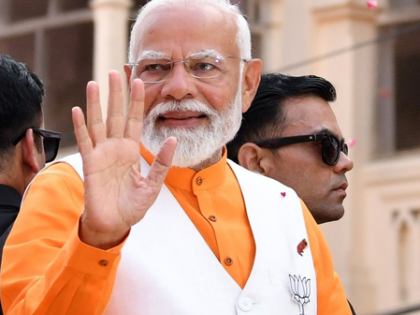24 years, 1 leader, a transformed nation: The Modi era and India's civilisational turning point
By IANS | Updated: October 7, 2025 22:35 IST2025-10-07T22:32:30+5:302025-10-07T22:35:05+5:30
New Delhi, Oct 7 As Prime Minister Narendra Modi steps into his 25th consecutive year as the head ...

24 years, 1 leader, a transformed nation: The Modi era and India's civilisational turning point
New Delhi, Oct 7 As Prime Minister Narendra Modi steps into his 25th consecutive year as the head of an elected government — first as Gujarat’s Chief Minister in 2001 and then as India’s Prime Minister since 2014 — it marks not just a political milestone, but a civilisational pivot.
In a democracy as vast, diverse, and contentious as India’s, such longevity is rare. But even rarer is the transformational scale of change one leader has overseen — changes that many nations strive for over generations, if ever.
India today is not merely progressing; it is being redefined — structurally, psychologically, and morally. A new governance model has emerged: accountable, outcome-driven, participative, and generationally transformative. The Modi era is not just an era of leadership; it is an era of reimagination.
Akhilesh Mishra, CEO of BlueKraft Digital Foundation, outlines five unmistakable shifts that define and exemplify the transformative impact of the Modi era.
Accountable governance: From anecdotes to analytics
Prior to 2014, governance in India was opaque, process-driven rather than results-oriented, and allergic to accountability. Targets were set with no timelines, and outcomes were loosely tracked, if at all.
Under PM Modi, this has changed irreversibly. Dashboards, real-time monitoring, and data-driven decision-making are now default norms across ministries. Schemes like Swachh Bharat, Jal Jeevan Mission, and PM Awas Yojana are monitored with GPS-tagged assets, live dashboards, and performance audits. Governance is no longer an exercise in paperwork but in measurable outcomes. A culture of "delivery" has replaced the legacy of drift.
From 'Chalta Hai' to 'Badal Sakta Hai': A nation's changed mindset
India's political culture had long been defined by fatalism — the infamous "chalta hai" attitude. That changed dramatically under PM Modi. Today, the nation believes in "badal sakta hai" (things can change) — and that belief is backed by results.
In 2014, a previous government had set a 2043 target for India to become the world’s third-largest economy. Today, that milestone is within reach by 2027 — nearly two decades ahead of schedule. The shift in national character is palpable: from passive acceptance to confident aspiration.
Security policy offers another stark contrast. The timid responses post-26/11 are now replaced by assertive doctrines — Balakot, surgical strikes, and a clear message: India will not be a silent victim anymore. This is not just a tactical shift, but a psychological one — the assertion of sovereignty and self-respect.
From “Ye Kaise Hoga?” to “Hoga Kaise Nahin?”: Mission mode governance
Before 2014, India's ambitions were often stalled at the altar of bureaucratic inertia and defeatism. “Ye kaise hoga?” (How will this ever happen?) was the common refrain across ministries and drawing rooms alike. Today, it's been replaced with a new mindset: “Hoga kaise nahin?” (How can it not happen?).
Take financial inclusion: despite decades of rhetoric, only 58 pc of Indians had bank accounts by 2014. Within a year of PM Modi’s Jan Dhan Yojana, that number shot past 90 pc. Today, India has over 500 million Jan Dhan accounts — the largest such network in the world.
Or consider Article 370 — long considered politically untouchable. Repealed. The Ram Mandir? Under construction. These are not just policies — they are symbols of a nation reclaiming its willpower. A "mission mode" approach now defines government functioning — with timelines, accountability, and resolve.
A national belief: “This is our time”
More than policy, what PM Modi has catalysed is belief — a widespread, cross-generational conviction that this is India’s moment.
Whether it’s in standing up to China at Galwan, calling out global hypocrisy, or launching the Chandrayaan mission to the Moon’s south pole — India today acts with the confidence of a civilisational power that has finally awakened. No longer hesitant, no longer deferential — India’s voice in global diplomacy, trade negotiations, and multilateral forums is now that of a leader, not a supplicant.
The same belief is seen in India’s startup boom, its Olympic medal tally, its booming stock market, and its digital public infrastructure. This is not just economic or geopolitical growth — it is national self-belief made manifest.
Civilisational renaissance: A nation rediscovers its soul
While GDP growth, infrastructure, and technology grab headlines, PM Modi’s most profound legacy may well be cultural: the rekindling of India's civilisational self-confidence.
For decades, India was taught to view its traditions with suspicion, its identity as backwards-looking, and its heritage as incompatible with modernity. PM Modi’s India challenges that narrative. From the majestic new Parliament building to the G20’s cultural diplomacy, from the Kashi Vishwanath Corridor to the Ram Mandir, a proud civilisational consciousness is back at the centre of national life.
This renaissance is not about nostalgia; it is about harmonising modernity with timeless values. It is India saying to the world: we are not just rising — we are returning. And in that return lies the future of the world’s largest democracy.
Disclaimer: This post has been auto-published from an agency feed without any modifications to the text and has not been reviewed by an editor
Open in app